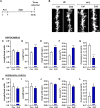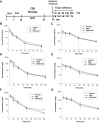Combined hyperforin and lanicemine treatment instead of ketamine or imipramine restores behavioral deficits induced by chronic restraint stress and dietary zinc restriction in mice
- PMID: 36091748
- PMCID: PMC9448861
- DOI: 10.3389/fphar.2022.933364
Combined hyperforin and lanicemine treatment instead of ketamine or imipramine restores behavioral deficits induced by chronic restraint stress and dietary zinc restriction in mice
Abstract
Clinical and preclinical studies show evidence that chronic stress or nutritional deficits in dietary zinc (Zn) intake may be risk factors for developing major depressive disorder (MDD). Furthermore, there may be possible links between low serum Zn levels and development of treatment-resistant depression. In the present work, we combined chronic restraint stress (CRS) and a low-zinc diet (ZnD) in mice and carried out a set of behavioral and biochemical studies. The mice were treated with four different antidepressant compounds, namely, ketamine, Ro 25-6981 (Ro), hyperforin and lanicemine (Hyp + Lan), and imipramine (IMI). We show that CRS or ZnD alone or a combination of CRS and ZnD (CRS + ZnD) induces anhedonia observed in the sucrose preference test (SPT). The behavioral effects of CRS were restored by ketamine or IMI. However, only Hyp + Lan restored the deficits in behavioral phenotype in mice subjected to CRS + ZnD. We also showed that the antidepressant-like effects observed in Hyp + Lan-treated CRS + ZnD mice were associated with changes in the morphology of the dendritic spines (restored physiological level) in the hippocampus (Hp). Finally, we studied the metabolism of ketamine and its brain absorption in CRS and CRS + ZnD mice. Our results suggest that CRS + ZnD does not alter the metabolism of ketamine to (2R,6R;2S,6S)-HNK; however, CRS + ZnD can induce altered bioavailability and distribution of ketamine in the Hp and frontal cortex (FC) in CRS + ZnD animals compared to the control and CRS groups.
Keywords: chronic stress; hyperforin and lanicemine; ketamine; refractory depression; zinc deficiency.
Copyright © 2022 Pochwat, Misztak, Masternak, Bączyńska, Bijata, Roszkowska, Bijata, Włodarczyk, Szafarz, Wyska, Muszyńska, Krakowska, Opoka, Nowak and Szewczyk.
Conflict of interest statement
The authors declare that the research was conducted in the absence of any commercial or financial relationships that could be construed as a potential conflict of interest.
Figures








Similar articles
-
Ketamine and Ro 25-6981 Reverse Behavioral Abnormalities in Rats Subjected to Dietary Zinc Restriction.Int J Mol Sci. 2020 Jul 6;21(13):4791. doi: 10.3390/ijms21134791. Int J Mol Sci. 2020. PMID: 32640759 Free PMC article.
-
Zinc Deficiency Blunts the Effectiveness of Antidepressants in the Olfactory Bulbectomy Model of Depression in Rats.Nutrients. 2022 Jun 30;14(13):2746. doi: 10.3390/nu14132746. Nutrients. 2022. PMID: 35807926 Free PMC article.
-
Hyperforin Potentiates Antidepressant-Like Activity of Lanicemine in Mice.Front Mol Neurosci. 2018 Dec 12;11:456. doi: 10.3389/fnmol.2018.00456. eCollection 2018. Front Mol Neurosci. 2018. PMID: 30618608 Free PMC article.
-
BDNF-TrkB signaling-mediated upregulation of Narp is involved in the antidepressant-like effects of (2R,6R)-hydroxynorketamine in a chronic restraint stress mouse model.BMC Psychiatry. 2022 Mar 15;22(1):182. doi: 10.1186/s12888-022-03838-x. BMC Psychiatry. 2022. PMID: 35291971 Free PMC article.
-
Fast-acting antidepressant activity of ketamine: highlights on brain serotonin, glutamate, and GABA neurotransmission in preclinical studies.Pharmacol Ther. 2019 Jul;199:58-90. doi: 10.1016/j.pharmthera.2019.02.017. Epub 2019 Mar 7. Pharmacol Ther. 2019. PMID: 30851296 Review.
Cited by
-
Changes in synaptic markers after administration of ketamine or psychedelics: a systematic scoping review.Front Psychiatry. 2023 Jun 26;14:1197890. doi: 10.3389/fpsyt.2023.1197890. eCollection 2023. Front Psychiatry. 2023. PMID: 37435405 Free PMC article.
References
-
- Bijata M., Baczynska E., Muller F. E., Bijata K., Masternak J., Krzystyniak A., et al. (2022). Activation of the 5-HT7 receptor and MMP-9 signaling module in the hippocampal CA1 region is necessary for the development of depressive-like behavior. Cell Rep. 38, 110532. 10.1016/j.celrep.2022.110532 - DOI - PubMed
LinkOut - more resources
Full Text Sources
Research Materials
Miscellaneous

